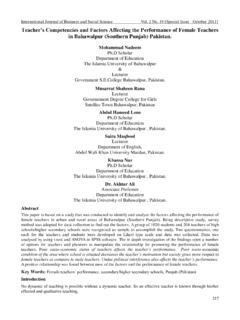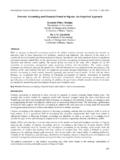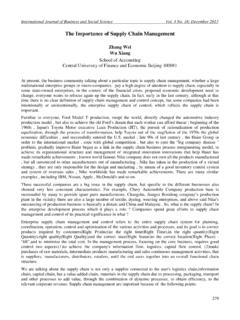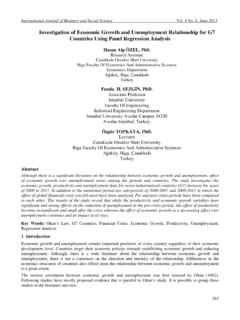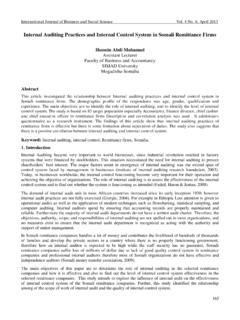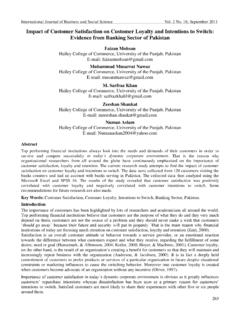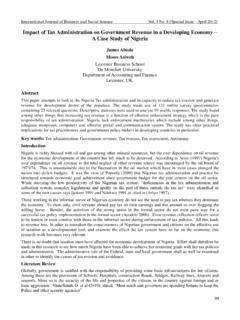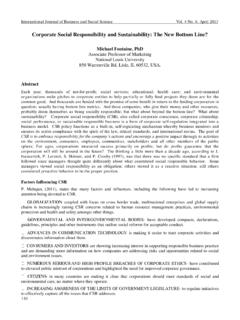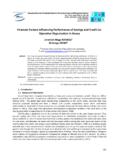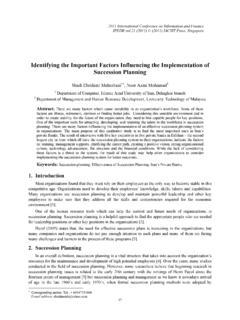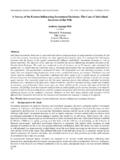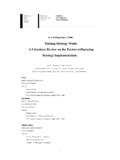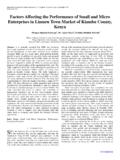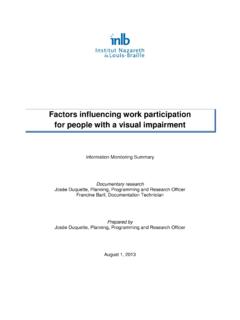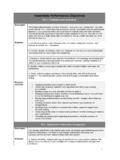Transcription of Factors Influencing Employee Performance …
1 International Journal of Business and Social Science Vol. 3 No. 20 [Special Issue October 2012] 37 Factors Influencing Employee Performance appraisal System: A Case of the Ministry of State for Provincial Administration & Internal Security, Kenya George Ndemo Ochoti Jomo Kenyatta University of Agriculture and Technology Department of Business Administration BOX 62000-00200 Nairobi. Kenya Dr. Elijah Maronga, EdD Jomo Kenyatta University of Agriculture and Technology Department of Business Administration BOX 62000-00200 Nairobi. Kenya Dr. Stephen Muathe, PhD Kenyatta University School of Business P. O. BOX 43844-00100 Nairobi. Kenya Robert Nyamao Nyabwanga Kisii University College Department of Business Administration Box 408-40200 Kisii.
2 Kenya Peter Kibet Ronoh Jomo Kenyatta University of Agriculture and Technology Department of Business Administration BOX 62000-00200 Nairobi. Kenya Abstract This study investigated the multifaceted Factors Influencing Employee Performance appraisal System in the Ministry of State for Provincial Administration, Nyamira District, Kenya. A target population of 76 employees was surveyed. A structured questionnaire was self-administered to the employees to collect data. Multiple regression analysis technique was used to explain the nature of the relationship between PAS and the Factors that influence it. Results of the study showed that all the five Factors : Implementation process (X1), interpersonal relationships (X2), rater accuracy (X3), informational Factors (X4), and Employee attitudes (X5) had a significant positive relationship with the Performance appraisal system (Y).
3 The regression results also showed that of the variation in Performance appraisal system can be explained by the changes in implementation process, interpersonal relationships, rater accuracy, informational Factors and Employee attitudes. With these findings, this study provides many implications for the implementation of Performance appraisal systems. It shows that if these Factors are taken into consideration by the ratees, the raters and the government policy makers, the PAS can be a good Performance management tool. Keywords: Performance appraisal System; Employee Attitude; Psychometric Rater Accuracy, Monitoring Performance ; Performance Management; Government of Kenya.
4 The Special Issue on Current Trends in Social Science Centre for Promoting Ideas, USA 38 1. Introduction Background of the study There are many challenges which hinder the delivery of public service reforms in Africa (Lienert, 2003). The Factors include those relating to human resources like manpower deficiencies and lack of psychological dispositions and shortage of financial and material resources necessary for effective delivery of services. The problems of accountability as well as ethical issues also continue to affect effective delivery of public service. In an effort to mitigate some of these challenges, the Government of Kenya (GOK) has in the past launched several reform programs to improve service delivery.
5 Some of these reform efforts include the Civil Service Reform Program (CSRP) (GOK, 1993) whose aim was to enhance public service efficiency and productivity. The program was designed to contain costs, improve Performance in the public sector, and consolidate and sustain the gains made by reform initiatives (Opiyo, 2006). The other reform initiatives included the implementation of Results Based Management that was guided by Economic Recovery Strategy for Wealth and Employment creation (GOK, 2003) whose strategies included developing benchmarks and evaluating the Performance of public institutions. In order to enhance the Performance of public officers, the government introduced a program where rewards and sanctions were to be used to encourage provision of quality services in the public sector.
6 This paved way for the piloting of the process of in state corporations in 2003 which saw the introduction and implementation of Performance appraisals in the entire public sector. Most firms in Kenya now employ some Performance appraisal system (GOK, 2009). The Performance appraisal System (PAS) was introduced by the GOK to refocus the mind of the public from a culture of inward looking to a culture of businesslike environment, focused on the customer and results in addition to improving service delivery (Obong'o, 2009). According to the new PAS, the evaluation of staff Performance is supposed to run concurrently with the duration of ministerial Performance contracts and the Government Financial year.
7 Targets should meet acceptable quality standards and benchmarks as determined in each category of service delivery; the system should be supported by training of staff, particularly those with managerial and supervisory responsibility; and the process should be regarded as interactive, for mutual agreement between supervisors and appraisers (GOK, 2009). Longenecker and Goff (1992), observed that managers and human resource professionals belief that a PAS is a good tool for human resource management and Performance improvement. If well designed and implemented it can benefit both the employees and the organizations (Coens and Jenkins, 2000).
8 According to GOK (2009), the PAS has caused a cultural transformation within the public service from a baseline of extremely poor Performance before 2003. The GOK has in the past made some efforts in launching and implementing Public Service Reform initiatives aimed at improving the Performance of public servants in service delivery (GOK, 1993; GOK, 2003). However, these reforms have not achieved the envisaged results (AAPAM, 2005; Opiyo, 2006). The introduction of the new PAS (GOK, 2006) is yet another attempt by the Government to manage and improve Performance of the Civil Service and Local Authorities by enabling a higher level of staff participation and involvement in planning, delivery and evaluation of work Performance .
9 Despite the successful roll out of the program, there is evidence of room for improvement in the process (GOK, 2009) and a lack of knowledge on the Factors that influence the PAS in the Ministry of State for Provincial Administration and Internal Security, (MoSPA) Nyamira district, Kenya. Specifically, this study addresses this gap by: (a) Establishing how the implementation process of the PAS in the public sector influences the system; (b) Determining how rater and ratee interpersonal relationship in a PAS context influences the system in the public sector; (c) Determining how psychometric rater accuracy in a PAS context influences the system in the public sector; (d) Determining how the level of information exchange between the rater and the ratee in a PAS context influences the system in the public sector.
10 And (e) Establishing how the attitudes of employees towards the last PAS rating, towards the rater and towards the PAS influence the system in the public sector. International Journal of Business and Social Science Vol. 3 No. 20 [Special Issue October 2012] 39 Research questions The following research questions applied in the study. a) Does the implementation process of the PAS influence the system? b) What is the influence of rater and ratee interpersonal relationship on the PAS? c) How does rater accuracy in a PAS context influence the system in the public sector? d) Does the level of information exchange between the rater and the ratee influence the PAS?
